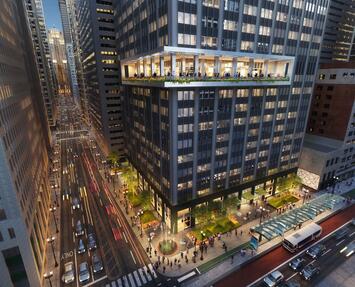
Let’s talk about the “urban doom loop”.
There were quite a few pundits who believed that the Covid pandemic would be the catalyst for a profound transformation of cities. Work-from-home opportunities will diminish the demand for office space in downtowns, they said. The loss of downtown office workers would cripple the commercial activity designed to serve them, creating even more building vacancies, they said. The low demand for office space will drive commercial property values down, result in declining property taxes, falling tax revenues for cities, worsening public services, rising crime and the outflow of residents – a downward spiral that would doom cities and favor suburbia, or small and midsize cities.
When I wrote on this topic three years ago, in the midst of the pandemic, I quoted an article from curbed.com written by someone who viewed the pandemic as the last straw:
“My reasons were less dramatic: Mostly, I fulfilled a deep desire for outdoor space. My longing to leave preceded the pandemic. I’ve spent the past eight years — since my second child was born — trying to free myself from our below-market-rate, duct-taped-together-but-beautiful fourth floor walk-up in Brooklyn.”
Yet I see cities that are bouncing back. Even with remote work becoming engrained in our economy now, people are returning to cities. Cities are exploring ways to adapt vacant downtown commercial space into new housing, transitioning downtowns from job centers to actual complete neighborhoods.
The urban doom loop phenomenon always seemed more like a wish by anti-urban types than an accurate take on the future of cities. There have been short-term impacts on cities related to the pandemic, but I believe cities have leaned in on their assets to weather the change.
In other words, the adaptability and experiential advantage of cities is preventing any doom loop from spiraling out of control.
Recently a piece in the Washington Post indicates the narrative might be changing somewhat. Stijn Van Neiuwerburgh, a professor of real estate and business at New York’s Columbia University, was one of the early proponents of the urban doom loop narrative at the start of the pandemic. But he’s since amended his views to focus more on midsize cities, rather than large ones:
“Midsize cities have a much bigger chasm to cross than what New York City has to go through. The situation is worse in those places with so little else in place.” He added, “It is a train wreck in slow motion.”
I think there’s a tacit acknowledgment by Neiuwerburgh that New York is returning to normal, despite its challenges. But in his mind, cities like Indianapolis and St. Louis, or Memphis and Minneapolis, don’t have the amenities and resources to recover in the same way New York does.
Neiuwerburgh, however, misses an important point. Relative to the hinterlands they serve, these midsize cities actually do have more amenities and resources. They’ve learned to capitalize on them.
Read the rest of this piece at Corner Side Yard Blog.
Pete Saunders is a writer and researcher whose work focuses on urbanism and public policy. Pete has been the editor/publisher of the Corner Side Yard, an urbanist blog, since 2012. Pete is also an urban affairs contributor to Forbes Magazine's online platform. Pete's writings have been published widely in traditional and internet media outlets, including the feature article in the December 2018 issue of Planning Magazine. Pete has more than twenty years' experience in planning, economic development, and community development, with stops in the public, private and non-profit sectors. He lives in Chicago.
Photo: Chicago is becoming a recognized leader in the adaptive reuse of office buildings for residential use. This image is of the 30 N. LaSalle Street building in Chicago, where a proposal to add 432 apartment units to replace vacant offices is being considered. This is one of several projects on LaSalle Street, the heart of Chicago's financial district, that could add more than 1,600 dwelling units to the Loop. Source: archpaper.com












